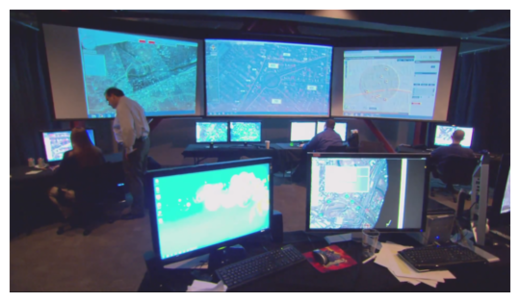
© Screenshot from Center for Investigative Journalism video
The Los Angeles County Sheriff's Department secretly used a civilian aircraft to monitor the 10-square-mile area of Compton in 2012, recording high-resolution video of all that happened n the region.
"We literally watched all of Compton during the times that we were flying, so we could zoom in anywhere within the city of Compton and follow cars and see people," said Ross McNutt of
Persistent Surveillance Systems, according to
The Atlantic.
This type of surveillance, which was used to find suspected bombers in Iraq and Afghanistan, allows police to zoom into recordings Google Earth-style.
The technology can stay in the air for six hours and is being marketed to police departments across the United States, allowing police to rewind recordings to watch areas they couldn't monitor in real time.
Sgt. Douglas Iketani of the L.A. County Sheriff's Department openly compared the secret test to Big Brother, though apparently it didn't make him stop short of using it.
"This system was kind of kept confidential from everybody in the public," Iketani said to the
Center for Investigative Reporting. "A lot of people do have a problem with the eye in the sky, the Big Brother, so to mitigate those kinds of complaints we basically kept it pretty hush hush."
The price point is also apparently quite attractive to police departments.
McNutt notes that the "whole system costs less than the price of a single police helicopter and costs less for an hour to operate than a police helicopter."
It is also capable of monitoring 10,000 times the area of a police helicopter.
"Our first initial thought was, oh, Big Brother, we're going to have a camera flying over us," Iketani said. "But with the wide area surveillance you would have the ability to solve a lot of the unsolvable crimes with no witnesses, no videotape surveillance, no fingerprints."
Conor Friedersdorf of
The Atlantic notes that Iketani didn't conclude that the technology would not be like Big Brother, but instead that the privacy problems would be outweighed by its law enforcement capabilities.
"I'm sure that once people find out this experiment went on they might be a little upset," Iketani said. "But knowing that we can't see into their bedroom windows, we can't see into their pools, we can't see into their showers. You know, I'm sure they'll be okay with it."
Ultimately, Iketani argues that the public has become accustomed to ubiquitous surveillance.
"With the amount of technology out in today's age, with cameras in ATMs, at every 7/11, at every supermarket, pretty much every light poll, all the license plate cameras, the red light cameras, people have just gotten used to being watched," he said.
While no police department has purchased the equipment yet, according to the CIR report, it is not due to the privacy problems inherent in such technology.
Instead, the problem is that the cameras currently can't identify the faces of individuals, a barrier which Friedersdorf says will likely be broken soon.

Reader Comments
to our Newsletter